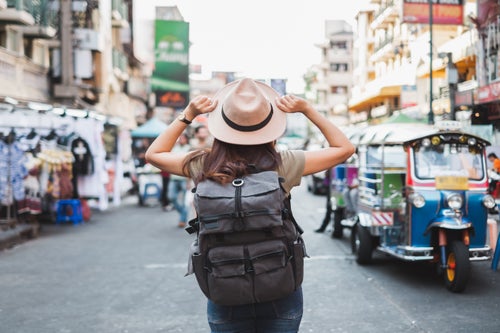

Travelling with allergies is a minefield. And, when your allergy is a life-threatening one, it can all but ruin a trip. On a work visit to Thailand, a country where the cuisine regularly contains peanuts, it became a source of stress for me. I eventually ended up sticking to hotel food rather than sampling the street vendor offerings that the country is famous for – and I left feeling like I’d missed out.
For me, one of the best experiences about visiting a new country is the food, and I make a point to only eat traditional cuisine when I am abroad. With my nut allergy, it can certainly make things tricky, and adds an extra level of planning, but with the right preparation, having an allergy shouldn’t stop you from living life to the full.
Here are my top tips to travelling with a nut allergy.
1. Give the airline a heads up.
I don’t actually ever eat plane food because, well, it’s horrible, so I always bring my own. However if you are intending on eating, then you need to give the airline a heads up as soon as possible, ideally when you book your ticket. You can also do some research to find the friendliest airline for nut allergy sufferers, or check out this comparison guide.
2. Research the food before you go.
Find out what the traditional dishes are - most countries will have a handful they’re famous for - and check out what they contain. If there’s one, for example pad thai, where one of the predominant ingredients is nuts, then you know to steer clear when you see it on the menu.
3. Learn some of the language.
If you’re visiting a country where the language is relatively easy to pick up, like France, Spain or Italy, then learn a few phrases. “I’m allergic to nuts,” “does this contain nuts”, or “I can’t eat nuts” are good variations to know.
4. Write down key phrases.
If you’re visiting Asia, or somewhere the languages are a little harder to master, then get some phrases printed out before you leave. When I visited my brother in Japan, he wrote down a list of my allergies on a piece of paper, and I would present it to the server before ordering my food. It helped, hugely. Make sure if you’re visiting a country with various dialects that you have translations in each one.
5. Download a translation app.
World Lens, Waygo and Microsoft Translator are apps which offer live translations. It’ll at least give you an idea of what dishes to avoid, rather than having to ask your server about every single dish on the menu.
“With the right preparation, there’s no reason why you can’t enjoy exploring a new country, and its cuisine, just like everybody else.”
6. Don’t get complacent.
Recipes can vary from region to region. In Mexico, some mole recipes contain peanuts, others don’t. I had a close call where I ordered a dish containing the sauce, as I’d previously had a nut-free version, only to find out seconds before I dug in that there were definitely peanuts in this one.
7. Don’t take risks.
I lived in Colombia for a while, where allergies aren’t very common. Despite telling my server I had a nut allergy, and her telling me the pesto on the pizza I was ordering was nut-free, there were nuts in it. I ended up suffering a very, very nasty reaction and having to use my Epipen. I should have trusted my instincts and steered well clear of anything pesto-related, as I knew pesto often contains nuts.
8. Research where the hospitals are, and what the emergency services number is.
When you’re in the middle of anaphylatic shock, the last thing you want is to be searching frantically on Google for the UK equivalent of 999 (trust me, I’ve been there). Save the number into your phone, and know where the nearest hospital to your accommodation is, so at least that’s one less thing to worry about.
9. Travel with emergency snacks.
I usually try to bring some cereal bars and a few packets of oatcakes with me in case I get desperate and can’t find anything suitable to eat. It doesn’t often happen, but it’s good to have them in case (and I always end up eating them anyway).
10. Carry antihistamines - and spare Epipens.
Thanks to my mum nagging me constantly, I now always carry antihistamines with me. They won’t save my life, but they buy me some time if I go into anaphylactic shock. And, if you’re not fatally allergic, then they will definitely help calm your symptoms. Also, make sure you travel with multiple Epipens as they’re not always available in every country if your one fails, or you need a second shot.
11. Don’t let your allergies put you off travelling.
I’m severely allergic to nuts and fish, and should definitely avoid mustard, kiwi and bananas. Despite this, I’ve been to Papua New Guinea, Lebanon, Armenia, Turkey, Antarctica, Israel, Guatemala, Morocco, Montenegro, to name a few, and I don’t plan to stop anytime soon. It can be scary, and there have been many times when I’ve just gone without food to avoid taking the risk (and many times where I’ve stupidly taken risks when I shouldn’t have). But with the right preparation, there’s no reason why you can’t enjoy exploring a new country, and its cuisine, just like everybody else.